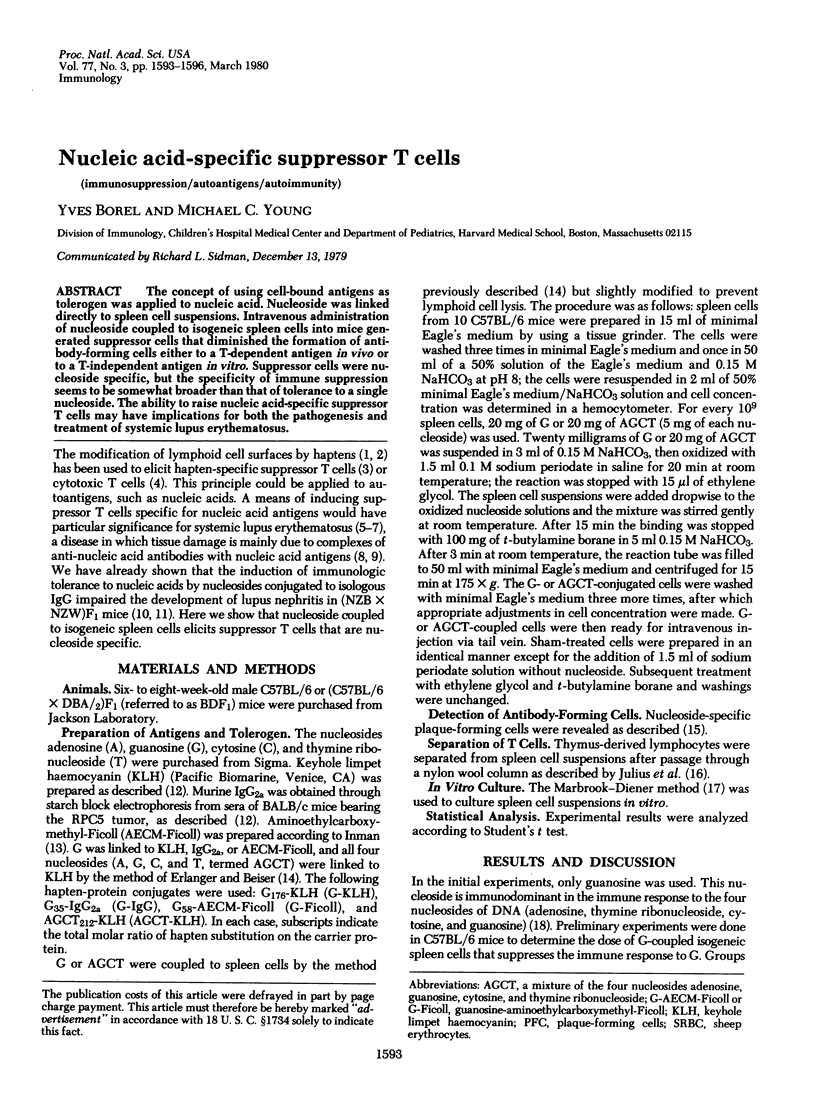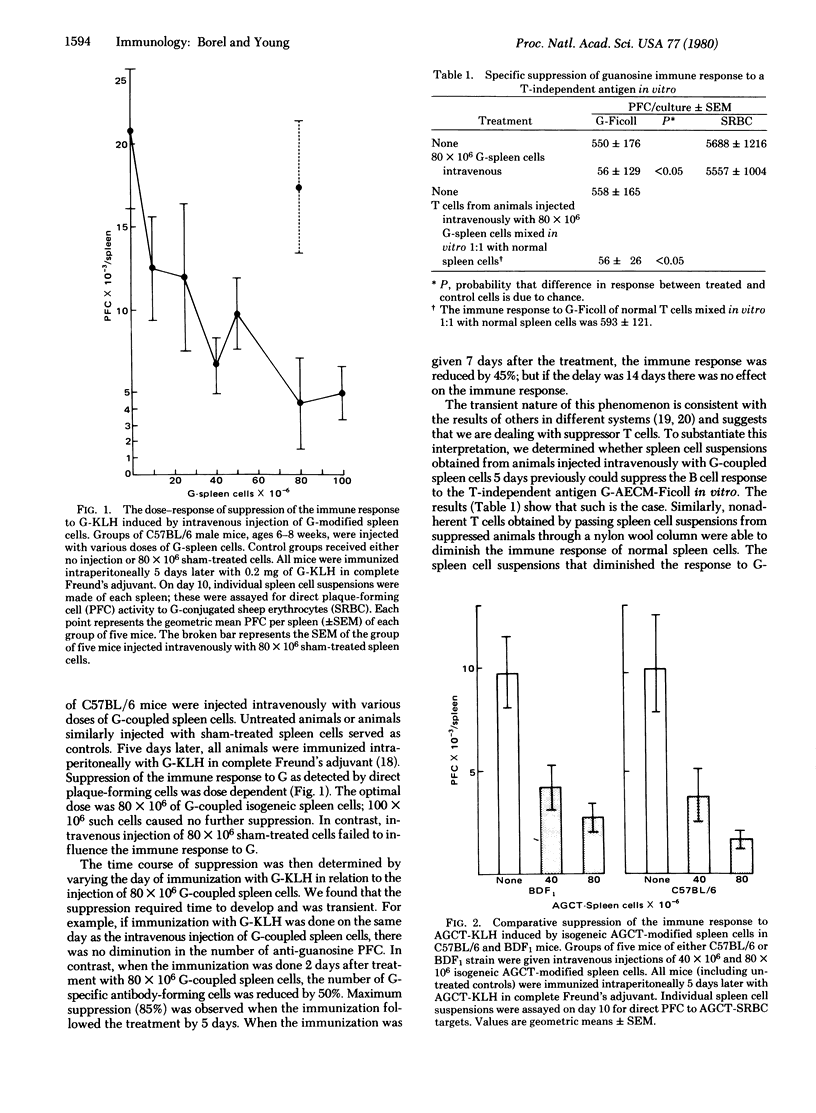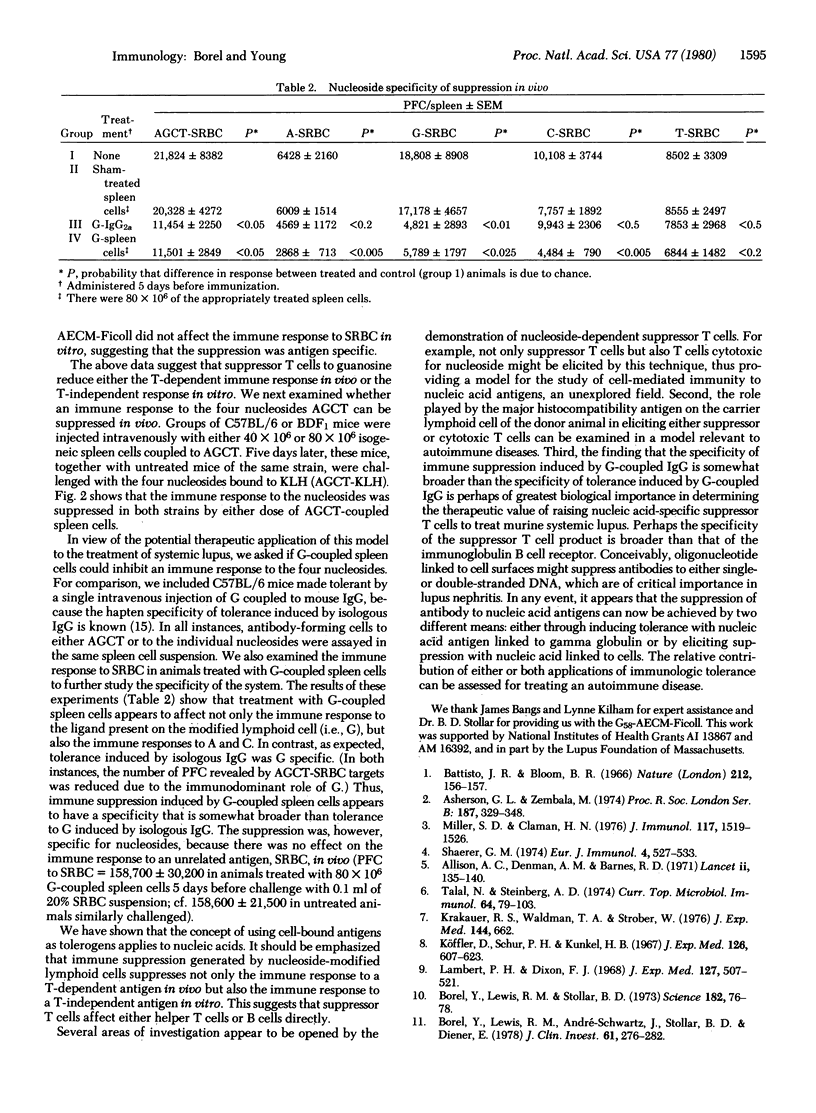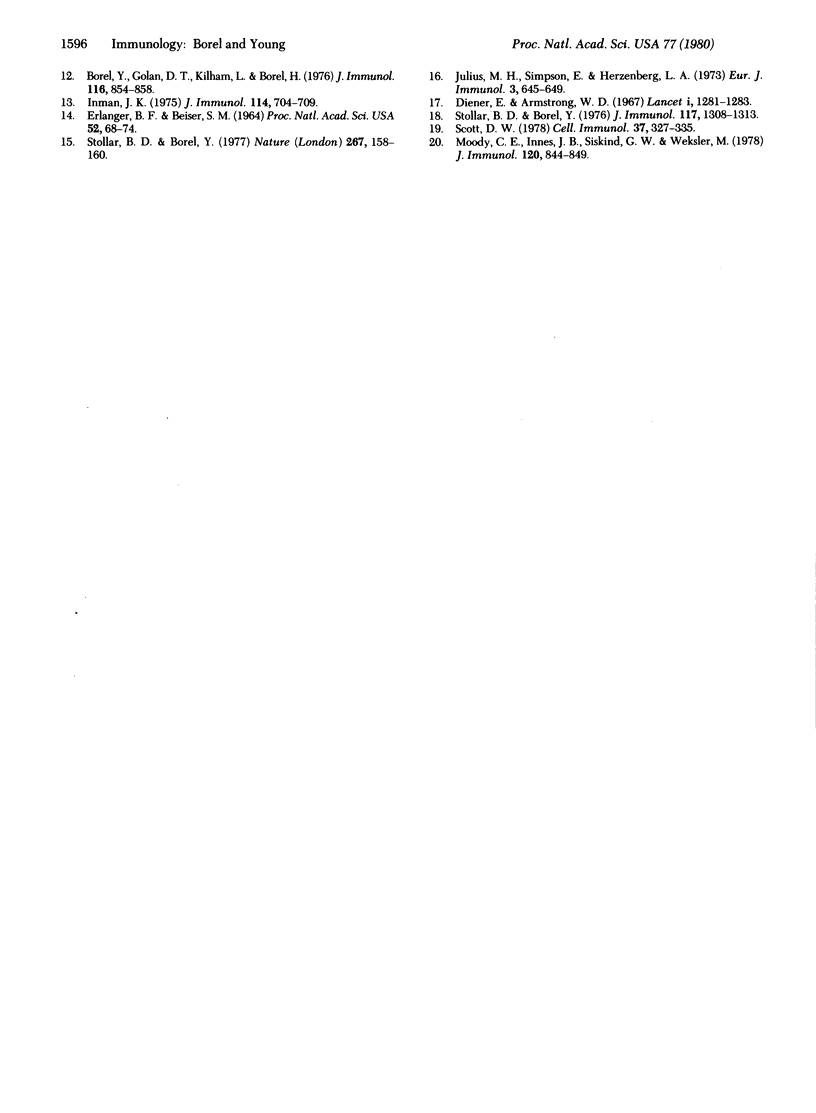Abstract
The concept of using cell-bound antigens as tolerogen was applied to nucleic acid. Nucleoside was linked directly to spleen cell suspensions. Intravenous administration of nucleoside coupled to isogeneic spleen cells into mice generated suppressor cells that diminished the formation of antibody-forming cells either to a T-dependent antigen in vivo or to a T-independent antigen in vitro. Suppressor cells were nucleoside specific, but the specificity of immune suppression seems to be somewhat broader than that of tolerance to a single nucleoside. The ability to raise nucleic acid-specific suppressor T cells may have implications for both the pathogenesis and treatment of systemic lupus erythematosus.
Full text
PDF



Selected References
These references are in PubMed. This may not be the complete list of references from this article.
- Allison A. C., Denman A. M., Barnes R. D. Cooperating and controlling functions of thymus-derived lymphocytes in relation to autoimmunity. Lancet. 1971 Jul 17;2(7716):135–140. doi: 10.1016/s0140-6736(71)92306-3. [DOI] [PubMed] [Google Scholar]
- Asherson G. L., Zembala M. Suppression of contact sensitivity by T cells in the mouse. I. Demonstration that suppressor cells act on the effector stage of contact sensitivity; and their induction following in vitro exposure to antigen. Proc R Soc Lond B Biol Sci. 1974 Nov 5;187(1088):329–348. doi: 10.1098/rspb.1974.0078. [DOI] [PubMed] [Google Scholar]
- Battisto J. R., Bloom B. R. Dual immunological unresponsiveness induced by cell membrane coupled hapten or antigen. Nature. 1966 Oct 8;212(5058):156–157. doi: 10.1038/212156a0. [DOI] [PubMed] [Google Scholar]
- Borel Y., Golan D. T., Kilham L., Borel H. Carrier determined tolerance with various subclasses of murine myeloma IgG. J Immunol. 1976 Mar;116(3):854–858. [PubMed] [Google Scholar]
- Borel Y., Lewis R. M., André-Schwartz J., Stollar B. D., Diener E. Treatment of lupus nephritis in adult (NZB + NZW)F1 mice by cortisone-facilitated tolerance to nucleic acid antigens. J Clin Invest. 1978 Feb;61(2):276–286. doi: 10.1172/JCI108937. [DOI] [PMC free article] [PubMed] [Google Scholar]
- Borel Y., Lewis R. M., Stollar B. D. Prevention of murine lupus nephritis by carrier-dependent induction of immunologic tolerance to denatured DNA. Science. 1973 Oct 5;182(4107):76–78. doi: 10.1126/science.182.4107.76. [DOI] [PubMed] [Google Scholar]
- Diener E., Armstrong W. D. Induction of antibody formation and tolerance in vitro to a purified protein antigen. Lancet. 1967 Dec 16;2(7529):1281–1285. doi: 10.1016/s0140-6736(67)90394-7. [DOI] [PubMed] [Google Scholar]
- ERLANGER B. F., BEISER S. M. ANTIBODIES SPECIFIC FOR RIBONUCLEOSIDES AND RIBONUCLEOTIDES AND THEIR REACTION WITH DNA. Proc Natl Acad Sci U S A. 1964 Jul;52:68–74. doi: 10.1073/pnas.52.1.68. [DOI] [PMC free article] [PubMed] [Google Scholar]
- Inman J. K. Thymus-independent antigens: the preparation of covalent, hapten-ficoll conjugates. J Immunol. 1975 Feb;114(2 Pt 1):704–709. [PubMed] [Google Scholar]
- Julius M. H., Simpson E., Herzenberg L. A. A rapid method for the isolation of functional thymus-derived murine lymphocytes. Eur J Immunol. 1973 Oct;3(10):645–649. doi: 10.1002/eji.1830031011. [DOI] [PubMed] [Google Scholar]
- Koffler D., Schur P. H., Kunkel H. G. Immunological studies concerning the nephritis of systemic lupus erythematosus. J Exp Med. 1967 Oct 1;126(4):607–624. doi: 10.1084/jem.126.4.607. [DOI] [PMC free article] [PubMed] [Google Scholar]
- Lambert P. H., Dixon F. J. Pathogenesis of the glomerulonephritis of NZB/W mice. J Exp Med. 1968 Mar 1;127(3):507–522. doi: 10.1084/jem.127.3.507. [DOI] [PMC free article] [PubMed] [Google Scholar]
- Miller S. D., Claman H. N. The induction of hapten-specific T cell tolerance by using hapten-modified lymphoid cells. I. Characteristics of tolerance induction. J Immunol. 1976 Nov;117(5 Pt 1):1519–1526. [PubMed] [Google Scholar]
- Moody C. E., Innes J. B., Siskind G. W., Weksler M. E. Tolerance induced by TNP-derivatized syngeneic erythrocytes: evidence for cooperation between hapten-specific T and hapten-specific B lymphocytes in the immune response. J Immunol. 1978 Mar;120(3):844–849. [PubMed] [Google Scholar]
- Scott D. W. Role of self carriers in the immune response and tolerance. III. B cell tolerance induced by hapten-modified-self involves both active T cell-mediated suppression and direct blockade. Cell Immunol. 1978 May;37(2):327–335. doi: 10.1016/0008-8749(78)90201-0. [DOI] [PubMed] [Google Scholar]
- Shearer G. M. Cell-mediated cytotoxicity to trinitrophenyl-modified syngeneic lymphocytes. Eur J Immunol. 1974 Aug;4(8):527–533. doi: 10.1002/eji.1830040802. [DOI] [PubMed] [Google Scholar]
- Stollar B. D., Borel Y. Nucleoside specificity in the carrier IgG-dependent induction of tolerance. J Immunol. 1976 Oct;117(4):1308–1313. [PubMed] [Google Scholar]
- Stollar B. D., Borel Y. Nucleoside-specific tolerance suppresses anti-nucleoside antibody forming cells. Nature. 1977 May 12;267(5607):158–160. doi: 10.1038/267158a0. [DOI] [PubMed] [Google Scholar]
- Talal N., Steinberg A. D. The pathogenesis of autoimmunity in New Zealand black mice. Curr Top Microbiol Immunol. 1974;64(0):79–103. doi: 10.1007/978-3-642-65848-8_3. [DOI] [PubMed] [Google Scholar]


